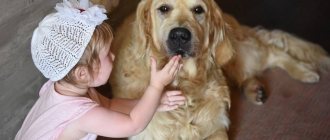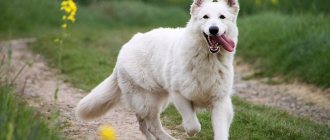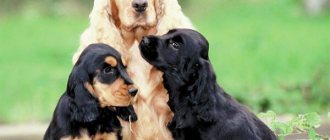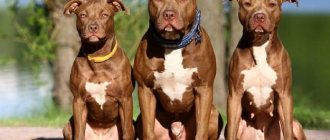- home
- Dogs
- Features of caring for small staffs and older dogs
Staff is a dog that appeared in our country relatively recently. Despite its rather dangerous and bloodthirsty reputation, the American Staffordshire Terrier immediately gained great popularity among both professional breeders and ordinary dog lovers. The reason for such a wide distribution of animals lies far from their fighting nature. Contrary to popular misconceptions, the breed is perfect for home keeping and guarding. An intelligent, sensitive, kind four-legged pet is ideal for families with children.
Staff is a dog that appeared in our country relatively recently.
History of the origin of staffs
The long history of Staffordshire Terriers dates back to distant England, where the ancestors of this breed, the English Bulldogs, grew up. The ancestors of the Staffs were widely valued for their fighting qualities. They were originally used as rat arena fighters. Later, when dog fights appeared, their organizers needed a more agile dog. And as a result of crossing bulldogs and terriers, pit bull terriers arose, combining the tenacity of the former and the agility of the latter. When dog fighting was banned, the new breed did not disappear: its brave representatives were very fond of the townspeople. The fashion for pit bull terriers lasted for a long time. Among wealthy and noble people it was considered prestigious to have such a famous pet at home.
Dog character
Staff is a smart and good-natured dog. Despite his rather intimidating appearance, sudden outbursts of aggression are completely atypical for him. The dog simply adores small children. She is optimally suited for large families and will become a loyal, devoted and reliable friend. However, only proper upbringing and care will help the dog show its best qualities.
The long history of Staffordshire Terriers dates back to distant England, where the ancestors of this breed, the English Bulldogs, grew up.
There are several characteristic breed traits that owners should be aware of.
- Staffs are very obedient and easy to train. The dog easily remembers what pranks are acceptable in the house, and what is strictly prohibited. Training an animal is absolutely easy. Even a child over 10 years old can easily cope with this task, but only under the close supervision of adults. Even small puppies quickly get used to obedience. For this quality they are highly valued and are often recruited to work in search and rescue services. It is representatives of this breed that become the best guides and rescuers. These dogs earned universal love during the rescue operation in Nord-Ost. With their help, specialists inspected objects before the assault began.
- Activity is another key quality of pets. They simply love having fun and cannot imagine their life without running, long walks and jumping. The more time the owner is willing to devote to the dog and the more games he offers it, the better. Staffords are absolutely not suitable for homebodies. If the dog does not expend his seething energy on a walk, he will definitely splash it out at home, causing serious damage. Therefore, it is extremely important to find time for long walks and games.
- Many people believe that the Staffordshire Terrier has an aggressive nature and is not averse to feasting on strangers. In fact, this is completely not true: the breed is very social, dogs love when their owners greet guests and adore children. Pets condescendingly tolerate all the tricks and pranks of younger family members, play with them with pleasure and even act as nannies. Staffs are no less friendly towards other four-legged animals they meet on a walk.
Staff is a smart and good-natured dog
Experienced dog breeders unanimously claim that the breed itself is incredibly loyal, friendly, calm and peaceful. This dog poses no threat. But the owner who trains and gives commands to the pet is dangerous for those around her. The staff obeys the owner unquestioningly and, without hesitation, carries out any order.
The fighting nature of Staffordshire Terriers manifests itself exclusively in battle. The dog is extremely aggressive towards the enemy; it is simply impossible to control him here. Therefore, all individuals that at least once showed aggression and hatred towards humans were immediately removed from breeding. This was done not only for safety, but also so that during dog fights opponents could be pulled apart with bare hands without fear of getting hurt.
The appearance of a pet in the house
If there is a small child in the family, you don’t have to worry, because the Amstaff’s behavior with children is distinguished by caution and understanding.
The dog knows very well that the child is much weaker and will succumb to the baby; it gets along well not only with children, but also with other pets.
Owners can recognize health problems by the following signs:
- Amstaff's nose is warm and completely dry, the pupils of the eyes are dull;
- poor sleep and loss of appetite;
- unpresentable appearance of dog hair, loss of shine;
- frequent urge to urinate, even breathing and wet mucous membranes.
American Staffordshire Terrier puppies need care and proper grooming. To prevent your dog from getting sick, you need to bathe it on time, walk it, and brush its teeth, ears and nose.
If you are thinking about buying a puppy of this breed, you need to know what types of terriers are available and what are their differences.
Features of pet care
Like any pet, adult Staf dogs and puppies require proper care. However, unlike many breeds, this one is absolutely unpretentious. It is enough to follow a few simple rules.
- Staffordshire Terriers do not need frequent bathing. Water procedures can be carried out at least 1-2 times a year. And to get rid of small hairs and particles of dead skin, it is enough to periodically wipe the dog’s fur with a damp towel.
- The Staff's coat must be brushed regularly. It is not recommended to use Furminator because the hair is too short for it.
- Staffies need regular walking and active pastime. It is important to spend at least 1.5-2 hours a day outside with them. It is advisable to play with your pet more often, throwing him a stick or a ball. A four-legged friend will be an excellent companion for athletes; they are great at agility. The dog will not leave its owner even if he decides to ride a bicycle. However, do not forget that in crowded places you need to put a harness on the animal.
- Both dry food and natural food are suitable for feeding Staffies. If you choose the first option, don't skimp on food. Cheap food can cause serious harm to your pet's health, so you should choose elite varieties. They will provide your pet with all the necessary vitamins and minerals. If natural food is chosen for feeding, the diet must include meat, offal, cereals, sea fish, eggs, and vegetables. The latter are best given boiled or stewed, so they are better absorbed.
From early childhood, the animal should be taught to be clean. It must sleep on its own bedding, which should be washed regularly. The dog should get used to relieving itself only outside.
Experienced dog breeders unanimously claim that the breed itself is incredibly loyal, friendly, calm and peaceful.
Sociable, balanced and friendly, the Staffordshire Terrier will make a wonderful pet. However, it should be remembered that he needs a leading, self-confident owner. The owner must become a mentor and leader. If you are confident that you can cope with this role, feel free to go and choose a puppy.
dogs-2091-1952-wallpaper
Feeding scheme with natural products
The nutrition of an adult dog should be tailored to its characteristics and activity. The staff's food portions need to be increased if he is undergoing training or needs to gain weight. You can calculate the daily volume using the formula:
- up to 6 months - 6-7% of body weight;
- after 6 months - 3-3.5% of the pet’s weight.
What to feed a kitten: diet for different ages
For example, for a pet older than 6 months and weighing 15 kg, you will need 600 g of food. One half should consist of fermented milk products, kefir, cottage cheese, and the second half (300 g) of raw meat. Raw vegetables and vegetable oil should not be included in the formula.
Note! During feeding, you should not mix dairy and meat products. Fermented milk products should be selected individually. High fat content can cause dyspepsia in some dogs.
Raising puppies
Staffordshire Terriers are mothers of many children. At one time, an Amstaff gives birth to 6 to 10 puppies. If you decide to get a four-legged pet of this breed, be sure to ask the breeder about its pedigree. You should also obtain information about the habits and feeding schedule, vaccinations, the character of the animal itself and its parents. If your pet has brothers and sisters from other litters, you should also ask about their habits. Particular attention should be paid to all this if you are going to take part in breed work and dog shows in the future.
Stafford puppies are incredibly active, playful and inquisitive. In order for their energy to go in the right direction, raising pets must be regular and consistent.
Breeders give several important recommendations for keeping a new family member.
- Typically, moving to a new home occurs in Staffordshire Terriers at 2 months. From the first day of life with its new owners, the dog must understand what can be done and what is strictly prohibited. All people living in the apartment must strictly follow the established rules. Otherwise, the animal will quickly become disillusioned with one owner and will seek loyalty from another.
- Staffies usually begin to change their baby teeth at 4 months. During this period, they scratch their jaws on everything that gets in their way, and they can chew off the owner’s important things. To prevent this from happening, you need to purchase special toys.
- Staff puppies must have their own place where they can rest and sleep peacefully. The sleeping area can be arranged in the hallway or the owner's room. It is important not to allow the animal to go to a person’s bed; then it will be extremely difficult to wean him from this habit.
- Despite the fact that the little dog is incredibly active, physical activity at a young age should be strictly dosed. Overwork can negatively affect your pet's health and lead to improper development of joints and skeletal bones.
- Only the owner should raise the animal. Outsiders are strictly prohibited from interfering in this process.
- After a walk, you need to wash the animal’s paws and carefully examine them for injuries and cuts.
- You can raise a baby only in commands, without shouting or assault. To scold an animal for disobedience, it is quite enough to speak to it in a stern voice.
- You can feed your little Staffordshire only after a walk. Active games and running on a full stomach can cause digestive problems and cause a sagging tummy. In addition, a well-fed puppy will get tired much faster and want to sleep.
- Bowls for food and drink must be on stands. Their height must be increased as the pet matures and grows.
- The puppy's daily diet should contain at least 30% protein food. Protein is the most important building material, which is especially necessary for a growing body.
In order for your little pet to always be healthy and cheerful, it is necessary not only to properly care for him, but also to get vaccinations in a timely manner. As a rule, the first vaccine is given to an animal at two months. Until this age, he is protected from diseases by immunity transmitted from his mother. 2 weeks before vaccination it is necessary to carry out deworming. A veterinarian will develop a detailed vaccination schedule. At about four months, the animal's teeth begin to change. If any vaccination falls during this time, it is better to reschedule it to avoid complications.
How to choose a diet for a Staffordshire Terrier
Meat should be the main product and make up half or most of the diet. Beef, veal, and horse meat are suitable for this. Poultry and rabbit meat are given carefully. Raw meat is preferable to cooked meat; it contains more nutrients, but requires pre-treatment with boiling water to kill parasites. By-products must be pre-cooked, except tripe. They differ in calorie content and can lead to unwanted weight gain. It is not advisable to give them daily. The diet can be varied with sea fish, from which the bones are first removed.
The diet includes chopped and whole vegetables - carrots, zucchini, pumpkin, beets, cucumbers. An adult dog can be given raw chicken and quail eggs. Fruits and berries such as bananas, apples, strawberries, blueberries are added to dairy products.
Important! When feeding natural products, the dog will need vitamin and mineral complexes.
Characteristic diseases of the breed
Like any dog breed, Staffies have several characteristic diseases. Most often found in animals:
- colitis;
- various skin diseases;
- gastrointestinal disorders;
- eye diseases, in particular cataracts;
- ligament ruptures and arthrosis;
- hip dysplasia.
Puppies are vaccinated against the most dangerous diseases, such as distemper, hepatitis, rabies and parainfluenza at an early age. And in order to avoid diseases, the likelihood of which is especially high in representatives of the breed, it is recommended to regularly visit the veterinarian for the purpose of prevention. Remember that any disease is easier to prevent than to cure.
By deciding to get a Staffordshire Terrier, you will find a reliable friend, a devoted protector and a loyal companion. The animal will become a full-fledged member of the family. The main thing is to give your pet as much attention and care as possible. Then he will repay you with sincere love and devotion. If you realize that you have little time to raise your pet, it is better to give preference to representatives of another breed.
Photo gallery
Despite the widespread opinion about the aggressiveness of this breed, it should be said that with proper care and education, your pet will pleasantly surprise others with its friendliness and calmness.
In this video you will see how a three-month-old American Staffordshire Terrier puppy is taught to behave correctly on the street.











